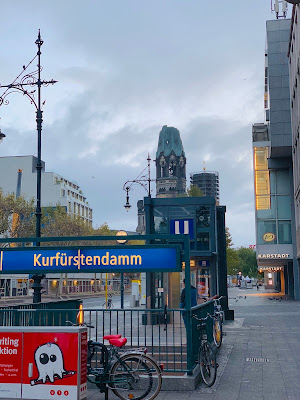The Kaiser Wilhem Memorial Church aka The Broken Tooth Church usually glows softly at me from the distance as I walk towards the train station but this morning, it looked as cold and forbidding as the sky behind it.
The sweater dress I wore is the grape coloured one on the left. The fit and flare knit dress was an impulse purchase because of its beautiful colour. But who knows, I might just get some wear out of it when I return to Sydney because it’s looking a bit cool and wet there at the moment.
I lasted five days but hump day got the better of me and I followed the signs out of the train station (Bahnoff Zoo / Berlin Zoologischer Garten if you’re taking notes and planning to do exactly the same thing when you’re next in Berlin) and climbed the stairs to Maccas. Where things were much the same as they are at home, except for some unique local menu items which I just know I’ll be back for before I leave.
The self serve touchscreens are multilingual and I got my coffee ordered in next to no time. The coffee was actually pretty good but it is also more expensive than the local kiosks and bakeries at the train station. The interesting thing is that while most other food outlets have fully automated coffee makers, Maccas had an actual barista!
The Memorial to the Murdered Jews of Europe is a stark and seemingly simple piece of sloping land covered in concrete slabs or ‘stelae’. The slabs are of different heights and arranged such that you can walk along rows of them but only one abreast. During sunny days like this, the shadows create a striped effect that echoes the striped uniforms worn by the Jews held in concentration camps. The slabs are coated in a special treatment that repels graffiti. Guards are also on hand and they frequently patrol to make sure no one stands on the slabs or defaces them.
The memorial cost about 25 million Euro to build and there is a museum underneath which holds the names of all the Jews who died at the hands of the Nazis. It is updated frequently as new names come to light.
A short walk away is a nondescript car park on a leafy street surrounded by well kept apartments. Despite this, groups of tourists congregate here around their guides. The universal sign that you’re close to something of historical significance.
Discrete yellow signs answer the question. The carpark sits on top of Adolf Hitler’s subterranean bunker and is the place where he committed suicide with Eva Braun his long time lover but wife of only 40 hours. The German government do nothing that could encourage this place to become a place of ‘worship’ of the regime, hence the car park and a small sign that states the fact as neutrally as possible.
My favourite is on the banks of the River Spree, a short walk from Hackescher Markt train station.
I’m so used to hearing only of the bleakness and deprivation of life in the DDR that to see colour and modernity on display as part of DDR life was a shock. East Germany was a strong advocate of women in the workforce and to facilitate this, they championed widely available child care for all women. On the surface it looks exactly like daycare anywhere else but exhibits show that attention to uniformity and ‘the group’ begins early in the life of East Germans. There is a protocol for how the children are to be toilet trained. Everyone goes at the same time and everyone waits for the last child to finish!
Within the museum is a recreation of an average DDR owned state housing.
The rooms were decorated authentically to how they might have been furnished at the time.
Along the way, there were creatively presented pieces of information like this wall behind a stove top which outlines the proportion of women in various industries in the DDR. For all its oppression of the group, women did have more career opportunities than their contemporaries in the ‘free world’.
This figure on the inside of a wardrobe details the number of Olympic Medalists hailing from East Germany in different sports. The DDR made things work but often at a huge price to the individual.
There was a huge price to pay by those who chose to question or to try to escape. Imprisonment, torture, forced adoption of children and the constant tension of being watched (even by those you loved and thought you knew).
Well worth a visit.
 |
| Fragments of the wall as art. |
Unfortunately, I wasn’t in luck when it came to visiting the Anne Frank Museum. I found it okay but it was closed and won’t reopen until November.
The walls are a dynamic canvas.
Artists have added to the wall in their unique styles and though they’re all so different, the differences work well together.
My last photo (promise) of this post is one of the nearby Chameleon Cinema.

































